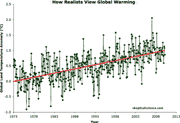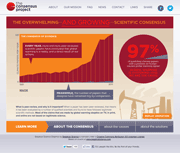PROTECT YOUR DNA WITH QUANTUM TECHNOLOGY
Orgo-Life the new way to the future Advertising by Adpathway

Latest Posts
- Fact brief - Is global warming actually happening?
- Climate Sensitivity
- 2025 SkS Weekly Climate Change & Global Warming News Roundup #35
- Skeptical Science New Research for Week #35 2025
- Another pause?
- The surprising reasons floods and other disasters are deadlier at night
- Record solar growth keeps China’s CO2 falling in first half of 2025
- 2025 SkS Weekly Climate Change & Global Warming News Roundup #34
- Fact brief - Are surface temperature records reliable?
- Skeptical Science New Research for Week #34 2025
- Getting climate risk wrong
- Climate Adam - Is Permafrost Really a Climate Time Bomb?
- Factcheck: Trump’s climate report includes more than 100 false or misleading claims
- 2025 SkS Weekly Climate Change & Global Warming News Roundup #33
- Skeptical Science New Research for Week #33 2025
- The coolest new energy storage technologies
- IEA: Renewables will be world’s top power source ‘by 2026’
- Climate change brings more rapidly intensifying hurricanes; NOAA cuts makes forecasting them harder
- 2025 SkS Weekly Climate Change & Global Warming News Roundup #32
- Skeptical Science New Research for Week #32 2025
- The new DOE climate report
- How the DOE and EPA used and misused my research
- The Republican campaign to stop the U.S. EPA from protecting the climate
- 2025 SkS Weekly Climate Change & Global Warming News Roundup #31
- Skeptical Science New Research for Week #31 2025
- Two international courts just issued major climate rulings. Here’s what that means
- Fact brief - Is the greenhouse effect still debated among climate scientists?
- Have renewables decreased electricity prices: European edition
- 2025 SkS Weekly Climate Change & Global Warming News Roundup #30
- Skeptical Science New Research for Week #30 2025
Climate Sensitivity
Posted on 1 September 2025 by Ken Rice
This is a re-post from And Then There's Physics
- The 66% range is 2.6–3.9 K for the Baseline calculation and remains within 2.3–4.5 K under robustness tests.
- the corresponding 5–95% ranges are 2.3–4.7 K, bounded by 2.0–5.7 K.
- all three lines of evidence are difficult to reconcile with an equilibrium climate sensitivity, characterised by an effective sensitivity S, below 2K.
- the paleoclimate evidence provides the strongest evidence against S > 4.5 K.
All of this seems quite reasonable. A likely range from just above 2K to about 4.5K, little evidence to support an equilibrium climate sensitivity below 2K, and evidence against it being above 4.5K.
Unsurprisingly, however, Nic Lewis has views. He has a published a response in which he objectively combines climate sensitivity evidence and finds that
[t]he estimates of long-term climate sensitivity are much lower and better constrained (median 2.16 °C, 17–83% range 1.75–2.7 °C, 5–95% range 1.55–3.2 °C)
and that
[t]his sensitivity to the assumptions employed implies that climate sensitivity remains difficult to ascertain, and that values between 1.5 °C and 2 °C are quite plausible.
As far as I can tell, the differences are mostly due to different choices about the various parameters. Given that different choices of values can give such large variations in the results, does seem to suggest that climate sensitivity remains difficult to ascertain. However, it’s less clear that values between 1.5 °C and 2 °C are quite plausible, although it does depend on what one means by plausible.
I realise that one can select a set of potentially plausible parameters that will give values between 1.5°C and 2°C, but given that we’ve already warmed by ~1.5oC, that the planetary energy imbalance has recently been above 1 Wm-2, and that we haven’t yet reached in change in anthropogenic forcing equivalent to a doubling of atmospheric CO2, values in this range don’t seem particularly plausible.
I do like Nic Lewis’s work and I have learned quite a lot by working through some of it. However, I do think a weakness is a reluctance to properly interrogate why his work seems to suggest values for climate sensitivity that are lower than many other experts would regard as plausible.
I think there’s a tendency to think that if you’ve justified all your assumptions, carefully chosen your parameters, and ensured that the methodology is robust, that the results should then stand. In my view, it’s always worth sanity checking the results. I realise that you have to be careful of not introducing additional biases, but you also have to be careful of trusting a result simply because the analysis is supposedly objective.
THE ESCALATOR

(free to republish)



































 English (US) ·
English (US) ·  French (CA) ·
French (CA) ·